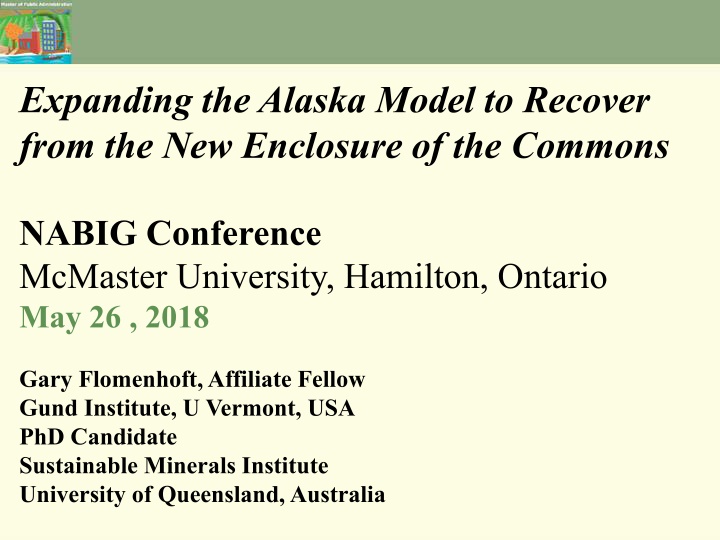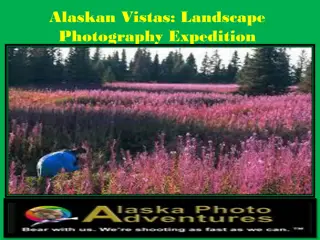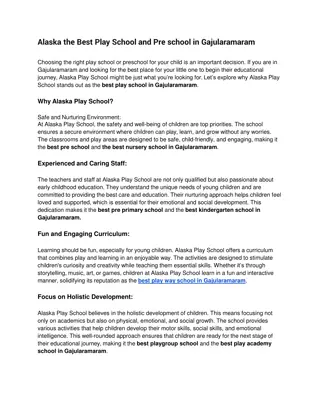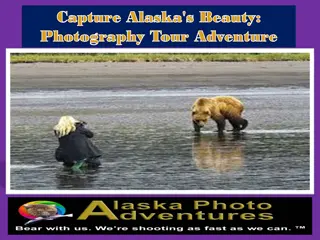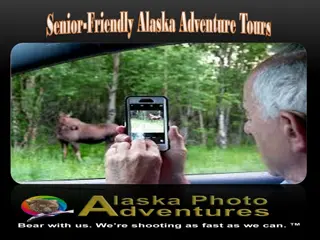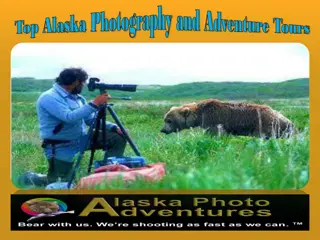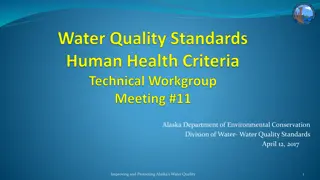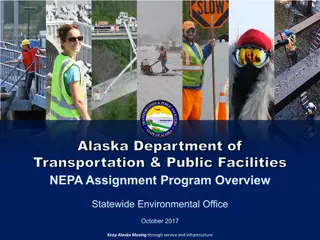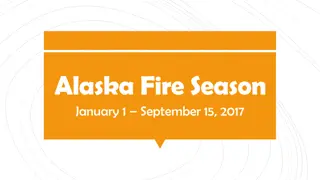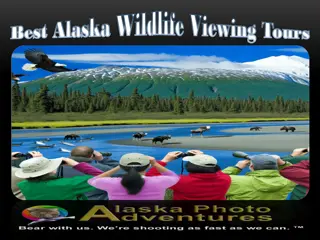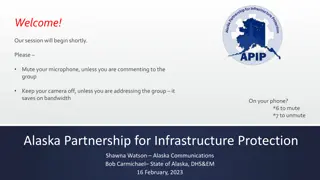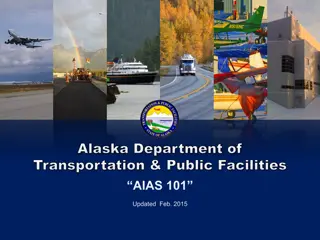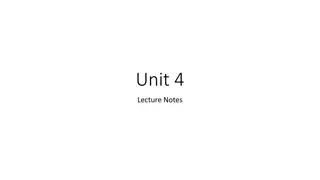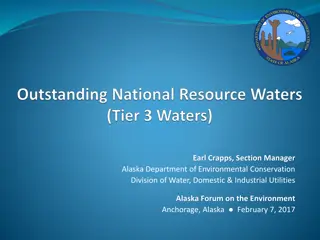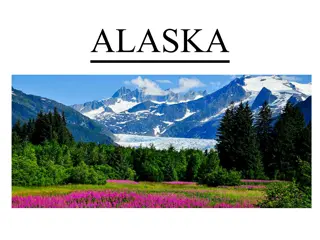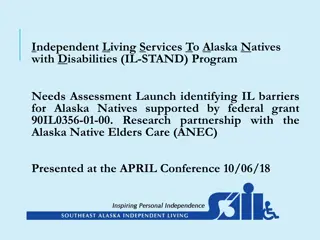Expanding the Alaska Model for Recovering from New Commons Enclosure
Implications of the new enclosure of the commons discussed at the NABIG Conference. Learn about increased working hours, housing price trends, university tuition costs, and the enclosures of labor, time, and knowledge. Discover how these developments affect various aspects of life and society.
Download Presentation

Please find below an Image/Link to download the presentation.
The content on the website is provided AS IS for your information and personal use only. It may not be sold, licensed, or shared on other websites without obtaining consent from the author.If you encounter any issues during the download, it is possible that the publisher has removed the file from their server.
You are allowed to download the files provided on this website for personal or commercial use, subject to the condition that they are used lawfully. All files are the property of their respective owners.
The content on the website is provided AS IS for your information and personal use only. It may not be sold, licensed, or shared on other websites without obtaining consent from the author.
E N D
Presentation Transcript
Expanding the Alaska Model to Recover from the New Enclosure of the Commons NABIG Conference McMaster University, Hamilton, Ontario May 26 , 2018 Gary Flomenhoft, Affiliate Fellow Gund Institute, U Vermont, USA PhD Candidate Sustainable Minerals Institute University of Queensland, Australia
QUOTES 1848-John Stuart Mill-Stationary State- more leisure time 1930-Keynes-by 2030-15 hr workweek 1932-Bertrand Russell-4 hrs per day 1970-Buckminster Fuller-11hrs per week 2000s-Juliet Schorr-The Overworked American
WHAT HAPPENED? Increased working hours Working Hours
Rule #4 4. Enclosure of Labor and Time Labor Productivity increase 130% Globalization
Cost of University Tuition Tufts University 1977-$3300 2018-$14,000 (adjusted for CPI) 2018-$55,172 (actual) 55/14 = 4X CPI
ORIGINAL ENCLOSURE ACTS: ENGLAND 1. 1750-1860: Common land enclosed/ 21% of British land area (http://en.wikipedia.org/wiki/Inclosure_Acts)
NEW ENCLOSURE OF THE COMMONS How the 1% does it Every aspect of life enclosed/privatized 1. Enclosure of money and finance 2. Enclosure of democracy and governance 3. Enclosure of land and resources 4. Enclosure of labor and time 5. Enclosure of knowledge and education 6. Enclosure of culture Neo-liberalism/globalization/Wash Consensus/TINA NOT Market vs. State! Enclosure of the Commons with complicity of the state (Silent Theft-Bollier)
THE NEW ENCLOSURES of the COMMONS 1. Enclosure of Money and Finance Central Banks are private banks Commercial banks produce 97% of the money supply through loans, and collect interest* Federal government has to borrow money from banks and foreigners, when it has the right to issue money itself interest- free. Colonial Scrip/Greenbacks (1861-1994) (Fed Reserve QE3=$85B/mo = $1T/year Why not Basic Income? = $3164/person/yr) *http://www.bankofengland.co.uk/publications/Documents/quarterlybulletin/2014/qb14q1prereleasemoneycreation.pdf
THE NEW ENCLOSURES 2. Enclosure of democracy and governance- plutocracy/ money party always wins -Zensey A. 80-98% of candidates with most money wins B. 2012-$4.2 billion spent on election C. $3 billion for TV ads on public airways (98% private) D. SuperPACS-Citizen s United=unlimited donations
THE NEW ENCLOSURES 3. Enclosure of Land and Resources (Banks own most land not people) 2008 GFC was a Land Bubble! US oil royalty rate = 12.5%. 93rd lowest of 104 oil and gas fiscal systems evaluated * * http://finance.fortune.cnn.com/2012/04/23/oil-drilling-federal-land/
THE NEW ENCLOSURES 4. Enclosure of Labor and Time Working Hours
THE NEW ENCLOSURES 5. Enclosure of Knowledge and Education Debt peonage-$1.5 trillion Corn 32,000 genes evolved over thousands of years Monsanto GMO corn inserts a few genes. Claims patent rights. 125,000 Indian farmers commit suicide because they can t afford seed, and illegal to save seed.
WHOSE OX WILL YOU GORE? OR WILL IT GORE YOU?
Methods to Finance BIG I. Taxes A. Wealth, Income, or Sales taxes B. Elimination of means-tested social welfare programs C. Tobin tax or other taxes on financial transactions D. Taxes on natural resources or pollution II. Central Bank Credit Quantitative easing for the people / social credit: issuing money directly to citizens (helicopter money-Bernanke) III. Economic Rent (Rent for use of the commons) A. Natural Assets-Resource rents B. Socially Created Assets
Methods to Finance BIG I. Taxes Perceived as Robin Hood Violates reciprocity II. Central Bank Credit Emergency only-something for nothing III. Economic Rent (Rent for use of the commons) Share of common property
What is the Alaska Model? ($64.9B) Dividend YearDividend Amount 2017 2016 2015 2014 2013 2012 2011 2010 2009 2008 2007 2006 2005 2004 2003 2002 2001 2000 1999 1998 1997 1996 1995 1994 1993 1992 1991 1990 1989 1988 1987 1986 1985 1984 1983 1982 $1,100.00 $1,022.00 $2,072.00 $1,884.00 $900.00 $878.00 $1,174.00 $1,281.00 $1,305.00 $2,069.00 $1,654.00 $1,106.96 $845.76 $919.84 $1,107.56 $1,540.76 $1,850.28 $1,963.86 $1,769.84 $1,540.88 $1,296.54 $1,130.68 $990.30 $983.90 $949.46 $915.84 $931.34 $952.63 $873.16 $826.93 $708.19 $556.26 $404.00 $331.29 $386.15 $1,000.00 (rent from oil-non-renewable resource on state land)
What is the Alaska Model? 1. Collect Resource Rent 2. Put in a savings Fund (Sovereign Wealth Fund) 3. Invest the money 4. Pay interest as a dividend Q. Why create a savings fund? A. Non-renewable resource Q. If resource is renewable or non-depletable do you need a savings fund? A. No
Peter Barnes-Capitalism 3.0 Common Asset Dividends Natural assets Air, water, land, minerals, forests, fish/wildlife, broadcast spectrum, wind, etc Socially created assets: stock markets/finance, money-seigniorage, land value, internet & web Commons is our property: collect rent, not Robin Hood
Economic Rent on Oil 2008: $57-$125/barrel Cost per barrel extracted including normal profit: $20-$165)
Democratic or Liberal Theory of Rent? The liberal theory of rent (neo-liberalism): suggests that public resources should be privatized and employed to make profits, and that rents should remain in private hands either entirely, or enough to ensure investment in the industry The democratic theory of rent: suggests that governments should maximize their collection of rent to the benefit of their publics, who own the resources. (Warnock 2006: 6)
Vermont Common Asset Trust Fund In Exporting the Alaska Model, Widerquist/Howard Low High Estimate: including current taxes (US$ million) Total current economic rent Current Vt Tax (in millions of US$) Estimate: New Revenue potential (US$ million) Asset Explanation $3.07/ton CO2 new scarcity rent 3.2 10% depletion fee Explanation $300/ton Co2 25.1 tax + new revenue 30.2 tax + new revenue Air Wildlife & Fish Public Forests 27.9 25.1 30.2 1.96 14.7 27 25.9 10.4 2724.0 royalties + Groundwater Surfacewater Minerals Land Value 107.9 31.2 9.7 1,070.8 0 0 107.9 royalty on bottlers 31.2 6.0 severance tax 329.8 progressive profit 121.4 31.2 16.2 tax + new revenue 2143.0 Progressive profits groundwater fees new revenue user fees 3.7 741 5% land tax 10% land tax Wind 5.4 0.74 4.7 tax 172.5 tax rent on ISPs and Web domains Internet & web Broadcast spectrum 30.0 0 30.0 30.0 rent estimate 375.0 0 375.0 user fees 375.0 rent estimate .25% speculation Financial system Monetary system Total (millions of US$) Per capital dividend 269.0 35.7 0 0 269.0 35.7 tax 743.0 35.7 2009 Baker study 2004 loans 1% on loans 2,017.9 789.1 1,228.8 6,447.3 $1,972 $10,348 VT Population: 623,050 Farley, Constanza, Flomenhoft, Kirk.The Vermont Common Assets Trust: An institution for sustainable, just and efficient resource allocation, Ecological Economics 109 (2015) 71 79
Valuation $million Existing revenue $m Item Economic Rent-Land and Resources Land Residential Land Commercial Land Rural Land Other Total land Subsoil Minerals Oil and Gas PRRT Total Minerals and Petroleum Natural Monopolies EMS Corporate Commons fee Water Rights Utilities Airports Taxi Licenses Fishing Licenses Forestry Gambling License Public Transport Frontiers of Monopoly Domain Name Registration Patents Satellite Orbit Rights Internet Infrastructure Banking License Fees Existing Revenues Parking fees Liquor Licenses Vehicle rego, Driver License Sin Taxes - Tobacco, Alcohol % of valuation Raised $m Remainder $m ~2.5% 69,870 8,463 6,593 7,193 92,118 2,794,800 338,500 263,700 287,700 3,684,700 5.50% 153,714 22,002 14,504 15,791 206,011 32,813 8,092 83,844 13,540 7,912 8,599 113,894 6.5 Total Economic Rents In Australia As a Source For Basic Income (K. Fitzgerald, 2013 5.50% 5.50% 67,359 +14.637 40% 40% - - - - 20,229 40,905 1,500 39,405 10,560 1,382,000 50,000 220,000 1,919 25,000 2,100 20% 2% 2.60% 10% 40% 14,402 40% 2.7% 40% 2,122 1960/15=133.1 27,640 1,300 22,000 765 360 840 50 7,380 2,400 1,989 27,640 1,300 18,800 765 352.6 826.2 48.7 2,280 2,326 0 ? 3,200 0 7.4 13.8 1.3 5,100 Financing Basic Income; Addressing the Cost Objection Perreira, Editor Palgrave books 2017 1800 18,450 estimate 74 100 3 million 0.005% 10% 10% 40% 300 65 510 0 0 0 0 0 300 65 510 12,980 5,100 64,500 43,427 6,450 17,371 6,450 17,371 estimate Govt budget Govt budget Govt budget 250 0 0 0 0 4,000 5,294 12,510 (18,220 repealed) Carbon Tax Govt Non Tax Receipts TOTAL (AU$millions) Population (millions) Basic Income per capita 4,020 +14,200 18,220 10,162 $386,905 54,930 20,323 50% 0 $289,252 24.05 AU$12,027
Economic Rent-Land and Resources Land Residential Land Commercial Land Rural Land Other Subsoil Minerals Oil and Gas PRRT Basis of Rent Calculation 5.50% 6.5 5.50% 5.50% 40% 40%
Basis of Rent Calculation Natural Monopolies EMS Corporate Commons fee Water Rights Utilities Airports Taxi Licenses Fishing Licenses Forestry Gambling License Public Transport 20% 2% 2.60% 10% 40% 14,402 @ $25,000/ea 40% 2.7% 40%
Frontiers of Monopoly Domain Name Registration Patents Satellite Orbit Rights Internet Infrastructure Banking License Fees 3 million x $100 0.005% 10% 10% 40% Basic Income: AU$12,027/yr/person in Australia
